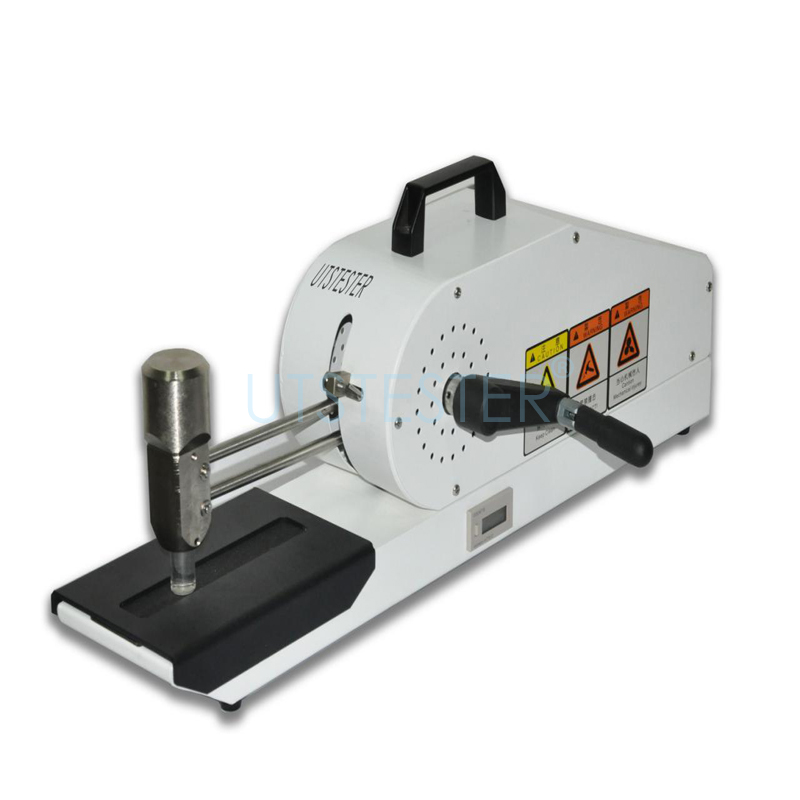 +86 152 6060 5085
+86 152 6060 5085
 +86 152 6060 5085
+86 152 6060 5085
2019-07-16
Industry AATCC Manual Crockmeter is a professional test instrument for evaluating the color fastness of textile samples subjected to dry or wet rubbing.
1.Sample Preparation
Dry staining test: Cotton cloth, samples or test area should be put into the condition for processing for 4 hours: Temperature of 21±1℃, relative humidity of 65±2% .
Wet staining test: White cotton cloth, sample or test area should be fully soaked in the distilled water, make it humidity reached 65±2%.
AATCC Rubbing Cloth
This is consumables should be purchased additionally.
Fabric to be Tested
The sample should be cut in the dimension of 50 mm x 150 mm to cover the metallic mounting plate. no damage and defect sample each six blocks, each direction with three pieces do dry staining test, three pieces do wet staining test.
If sample is yarn, should weave, or tightly wound in a proper shape, winding around should be according to the yarn length direction into 50 mmx150mm test area of sample.
The specimens for each must be such that one is assessed with the long direction parallel to the warp and other parallel to the weft. The wet test must be made with fresh dry samples and crocking cloths which have been wetted with water and squeezed to 100% take up (i.e. 10 grams of fabric is increased to 20 gm's of fabric plus water)
Sample and white cotton processing:
Dry staining test: put white cotton cloth, samples or test area in the atmospheric temperature is 21±1℃, relative humidity of 65±2% processing for 4 hours.
Wet staining test: place white cotton cloth, sample or test area completely soaked in the distilled water, then use laboratory wringer (available separately) or a similar method to squeeze the sample and white cotton cloth that placed in blotting paper, make it humidity reached 65±2%.

2.Operation
1.Determine the test types (dry friction test and wet friction test), and adopt the corresponding processed test pieces and white cotton cloth, and number them respectively.
2.Pull the hanging rod outward, rotate the positioning to make it unable to pop up, lift the friction hammer and put it on the hanging rod, and rotate the hanging rod to make it extend to hang the friction hammer connecting arm.
3.Specimen clamping and installation of white cotton cloth:
3.1 clamping of test pieces: remove the cover plate, lay the test sample processed as required on the friction table, face up, and press the test sample with the cover plate, and the test sample shall be flat without wrinkles.
3.2 installation of white cotton cloth: take a piece of white cotton cloth of standard size, align the center of the white cotton cloth with the center of the friction head, and then cover it with the friction hammer, put it into the white cotton cloth clamp, and then clamp the white cotton cloth.
3.3 check and finish the white cotton cloth and sample to make the friction surface smooth and firmly clamped.
3.4 put down the friction hammer and place the friction head on the surface of the sample.
(1)Start Testing
(2)long press the button on the counter to reset the current times.
(3) rotate the crank handle clockwise to make the friction head reciprocate for 10 times.
4. End of test:
4.1 follow the above steps 1.2 to hang the friction hammer with the hanging rod.
4.2 remove the sample pressing plate and take out the sample.
4.3 remove the white cotton clip and take out the white cotton for the evaluation results.
5. Result determination and test report
5.1 Result judgment: when evaluating, put three layers of friction cloth on the back of each evaluated friction cloth.Under the suitable light source, the stain grade of friction cloth was evaluated with grey sample card.
5.2 Test report:
The test report shall include the following contents:
(1)Number according to the test standard;
(2) Friction head for test;
(3) Test is dry friction or wet friction, if it is wet friction, indicate moisture content;
(4) Humidifying time of the sample and friction cloth;
(5) The length direction of the sample, i.e., meridional, zonal or oblique direction;
(6) Coloring series of each sample.
Email: hello@utstesters.com
Direct: + 86 152 6060 5085
Tel: +86-596-7686689
Web: www.utstesters.com
Previous article :
Description of Washing Colorfastness TesterNext article :
Pneumatic Bursting Strength Tester before operation